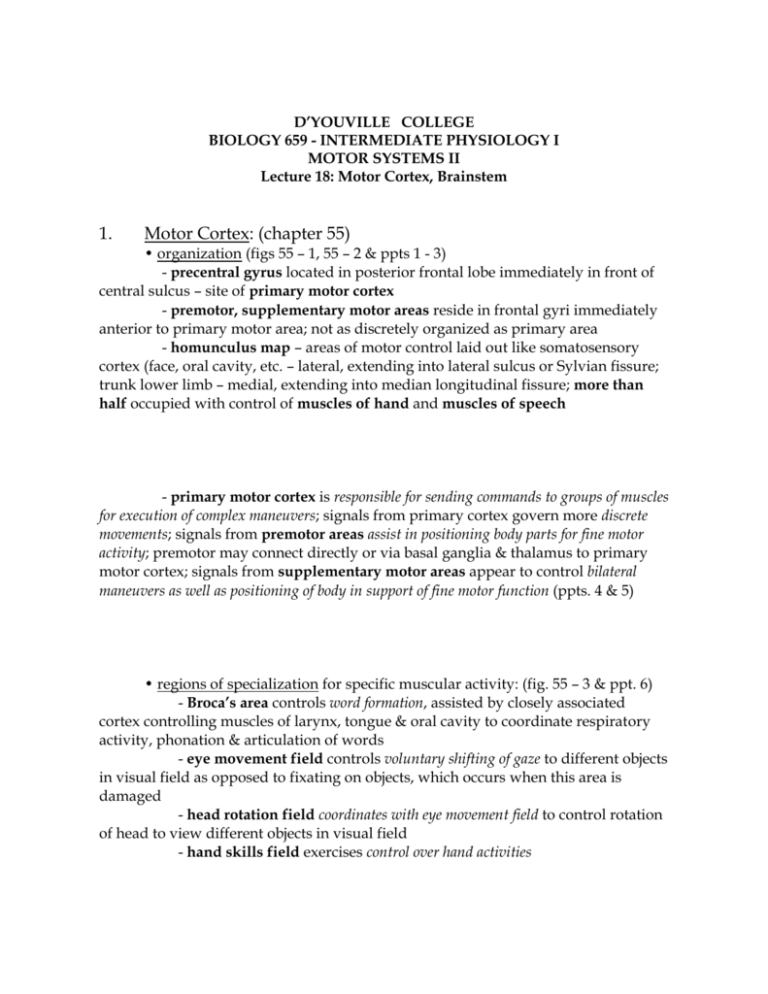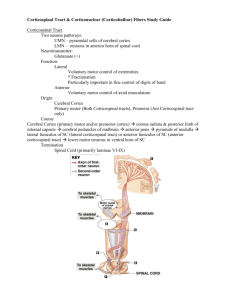18. Motor systems-cort
advertisement

D’YOUVILLE COLLEGE BIOLOGY 659 - INTERMEDIATE PHYSIOLOGY I MOTOR SYSTEMS II Lecture 18: Motor Cortex, Brainstem 1. Motor Cortex: (chapter 55) • organization (figs 55 – 1, 55 – 2 & ppts 1 - 3) - precentral gyrus located in posterior frontal lobe immediately in front of central sulcus – site of primary motor cortex - premotor, supplementary motor areas reside in frontal gyri immediately anterior to primary motor area; not as discretely organized as primary area - homunculus map – areas of motor control laid out like somatosensory cortex (face, oral cavity, etc. – lateral, extending into lateral sulcus or Sylvian fissure; trunk lower limb – medial, extending into median longitudinal fissure; more than half occupied with control of muscles of hand and muscles of speech - primary motor cortex is responsible for sending commands to groups of muscles for execution of complex maneuvers; signals from primary cortex govern more discrete movements; signals from premotor areas assist in positioning body parts for fine motor activity; premotor may connect directly or via basal ganglia & thalamus to primary motor cortex; signals from supplementary motor areas appear to control bilateral maneuvers as well as positioning of body in support of fine motor function (ppts. 4 & 5) • regions of specialization for specific muscular activity: (fig. 55 – 3 & ppt. 6) - Broca’s area controls word formation, assisted by closely associated cortex controlling muscles of larynx, tongue & oral cavity to coordinate respiratory activity, phonation & articulation of words - eye movement field controls voluntary shifting of gaze to different objects in visual field as opposed to fixating on objects, which occurs when this area is damaged - head rotation field coordinates with eye movement field to control rotation of head to view different objects in visual field - hand skills field exercises control over hand activities Bio 659 - lec 18 - p. 2 - • inputs: sensory cortex areas (somatosensory, visual, auditory), thalamus (including signals relayed from cerebellum & basal ganglia) send signals to modulate motor cortex output; received in layers 2 – 4 of motor cortex; once sensory input is received, cerebellum & basal ganglia collaborate with cortex to develop motor response 2. Brainstem: • midbrain: red nucleus located in midbrain; organized similarly to, but less precisely than motor cortex - red nucleus receives fibers directly from cortex (corticorubral tract) as well as collaterals from corticospinal tract; appears capable of similar but cruder control of motor activity compared to cortex • pons & medulla (fig. 55 – 7 & ppt. 7): nuclei for respiratory control, cardiovascular control & some GI control - reticular nuclei control postural muscles (modulated by other brain regions) - reticular nuclei of pons send excitatory signals to postural muscles - reticular nuclei of medulla send inhibitory signals to postural muscles (fig. 55 – 8 & ppt. 8) - vestibular nuclei facilitate pontine reticular system in excitation of postural muscles; activity of these nuclei is determined by inputs from vestibular (equilibrium) apparatus (see below) 3. Output Tracts: • corticospinal tracts (fig. 55 – 4 & ppt. 9): descend from layer 5 of cortex (30% primary motor cortex, 30% premotor & supplementary motor & 40% somatosensory fibers) to pyramids of medulla (pyramidal system) - majority of fibers cross to opposite side in pyramids (contralateral fibers) and continue down lateral corticospinal tract - smaller number of ipsilateral fibers descends in ventral corticospinal tract Bio 659 - lec 18 - p. 3 - - collaterals communicate with basal ganglia, brainstem (red nucleus) & cerebellum Bio 659 - lec 18 - p. 4 - • rubrospinal tract (fig. 55 – 5 & ppts. 10 & 11) closely parallels corticospinal fibers of lateral column of cord; like corticospinal tract, maintains prominent communication with cerebellum; together with corticospinal tract, constitutes lateral motor system of the cord • reticulospinal & vestibulospinal tracts: from reticular nuclei & vestibular nuclei of pons & medulla; descend in medial columns of cord (medial motor system) (fig. 55 – 6 & ppt. 12) - reticulospinal may be responsible for coordination of movements (requiring less dexterity & less balance) involving many segments of the cord (upper & lower limb movements for walking, swimming, etc.) - vestibulospinal is responsible for maintenance of balance (ppt. 13) 4. Equilibrium Apparatus (fig. 55 – 9 ppt. 14): bony & membranous labyrinths of internal ear, posterior to cochlea • utricle & saccule (ppt. 15): pouch-like chambers in vestibule of bony labyrinth - maculae – sensory spots in utricle (horizontal) & in saccule (vertical) involve hair cells (fig. 55 – 10 & ppts. 16 & 17) with overlying gelatinous layer with statoconia (otoliths) (ppt. 18); positive & negative signals are produced in vestibular nerve (branch of cranial n. VIII) in response to orientation of head relative to gravity (static equilibrium); differing orientation of hair cells accounts for differing patterns of signals for different orientations of head relative to gravity Bio 659 - lec 18 - p. 5 - • semicircular canals: three mutually perpendicular loops of membranous labyrinth (anterior – 'near sagittal’, posterior – ‘near coronal’ & lateral – horizontal) - crista ampullaris (fig. 55 – 11 & ppts. 19 & 20) – swelling at end of each semicircular canal contains a cupula (sensory hairs embedded in gelatinous mass) that responds to fluid movements through the semicircular canal; generates signals in vestibular nerve that carry information about ‘start-and-stop’ movements of the head (dynamic equilibrium) (ppt. 21) ; this provides an ‘anticipatory’ function (i. e., a change in direction during running anticipates an impending disturbance of equilibrium before it happens); static equilibrium organ only responds after disturbance has occurred







